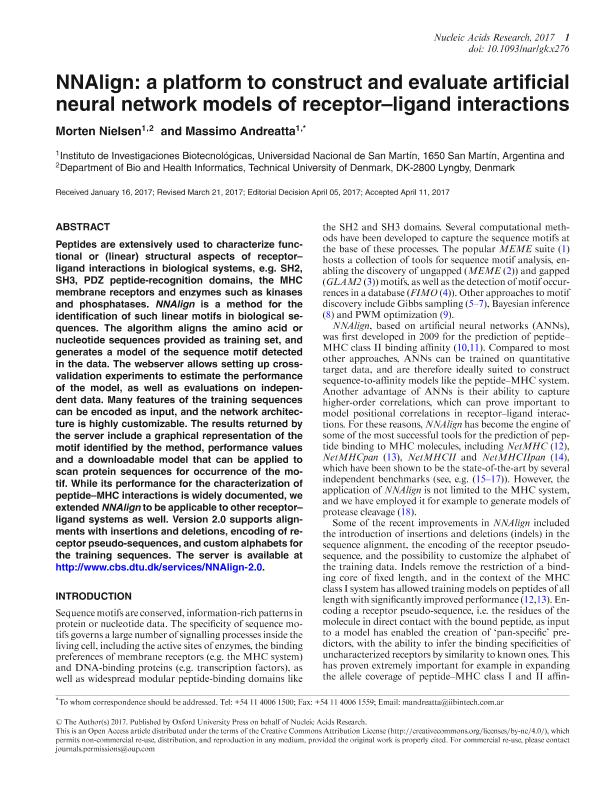Artículo
NNAlign: a platform to construct and evaluate artificial neural network models of receptor–ligand interactions
Fecha de publicación:
04/2017
Editorial:
Oxford University Press
Revista:
Nucleic Acids Research
ISSN:
0305-1048
e-ISSN:
1362-4962
Idioma:
Inglés
Tipo de recurso:
Artículo publicado
Clasificación temática:
Resumen
Peptides are extensively used to characterize functional or (linear) structural aspects of receptor–ligand interactions in biological systems, e.g. SH2, SH3, PDZ peptide-recognition domains, the MHC membrane receptors and enzymes such as kinases and phosphatases. NNAlign is a method for the identification of such linear motifs in biological sequences. The algorithm aligns the amino acid or nucleotide sequences provided as training set, and generates a model of the sequence motif detected in the data. The webserver allows setting up cross-validation experiments to estimate the performance of the model, as well as evaluations on independent data. Many features of the training sequences can be encoded as input, and the network architecture is highly customizable. The results returned by the server include a graphical representation of the motif identified by the method, performance values and a downloadable model that can be applied to scan protein sequences for occurrence of the motif. While its performance for the characterization of peptide–MHC interactions is widely documented, we extended NNAlign to be applicable to other receptor–ligand systems as well. Version 2.0 supports alignments with insertions and deletions, encoding of receptor pseudo-sequences, and custom alphabets for the training sequences. The server is available at http://www.cbs.dtu.dk/services/NNAlign-2.0.
Archivos asociados
Licencia
Identificadores
Colecciones
Articulos(IIB-INTECH)
Articulos de INST.DE INVEST.BIOTECNOLOGICAS - INSTITUTO TECNOLOGICO CHASCOMUS
Articulos de INST.DE INVEST.BIOTECNOLOGICAS - INSTITUTO TECNOLOGICO CHASCOMUS
Citación
Nielsen, Morten; Andreatta, Massimo; NNAlign: a platform to construct and evaluate artificial neural network models of receptor–ligand interactions; Oxford University Press; Nucleic Acids Research; 45; 1; 4-2017; 344-349
Compartir
Altmétricas




